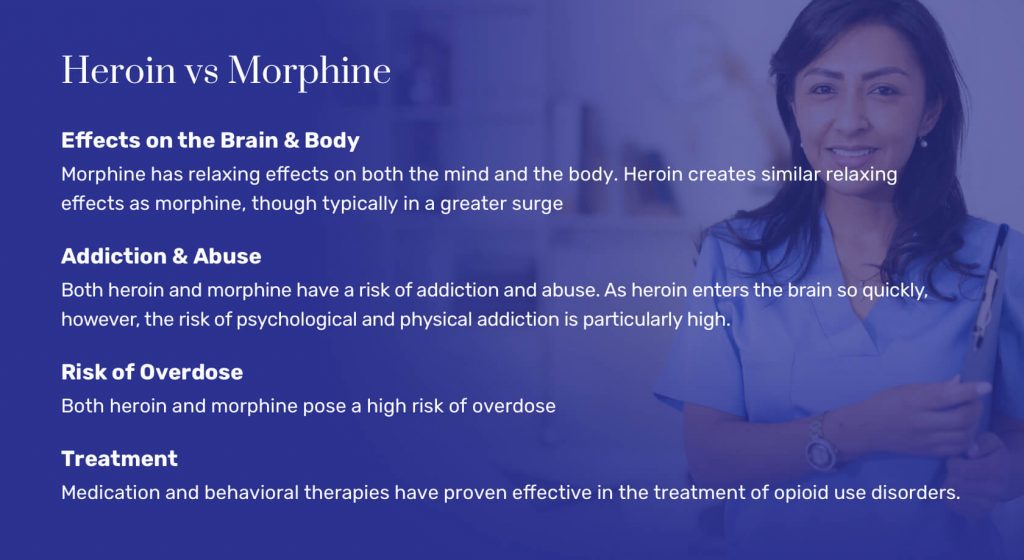Traditionally prescribed as a pain medication or used as a common ingredient in other medications, morphine is an opioid that can be legally obtained in the United States, though it comes with the potential for abuse and addiction.
Heroin produces similar effects as morphine and is in fact made from morphine, but it is an illegal opioid people commonly snort, inject, or smoke. Its use comes with dangerous side effects and risks, such as overdose and addiction.[1],[2]
Morphine vs. Heroin Comparison Table
| Morphine | Heroin | |
| Legal status | Legal with prescription | Illegal |
| Schedule | Schedule II | Schedule I |
| Forms | Oral solution, extended-release and immediate-release tablets, and injectable forms | White powder, brown powder, black tar heroin |
| How It’s Used | Orally or intravenously | Injected, smoked, or snorted |
| Street Names | White Lady, Salt and Sugar, Miss Emma, M, Morpho, Dreamer, God’s Drug | H, Smack, Junk, Dope, Snow, Horse, Hero, Beast, Skag |
| Common Drug Combinations or Adulterants | Alcohol or other opioids | Cocaine, fentanyl, carfentanil |
| Addiction potential | Moderate to High | High |
| Short-term effects | Relaxation, euphoria and pain-relief | Relaxation, euphoria and pain-relief |

Breaking Down Heroin & Morphine
Both heroin and morphine belong to the class of drugs called opioids. Opioid pain-relieving drugs are typically safe to use when taken as prescribed by a doctor and for a short period of time.
What is Morphine?
Morphine is a non-synthetic narcotic drug derived from opium. It is a naturally occurring substance made from the seed pods of certain poppy plants. It can be used directly for pain management or processed into other medications, such as codeine. [5]
Some researchers suggest that the use of prescription opioid drugs, such as morphine, can increase the risk of transitioning to heroin use since it’s cheaper and more potent.[2]
What is Heroin?
Heroin is a fast-acting drug derived from morphine. It is most commonly sold as a white or brown powder or as a sticky black substance referred to as black tar heroin. [1],[2]
Once consumed, heroin rapidly enters the brain and binds to opioid receptors that affect sensations of pain and pleasure. The same receptors are involved in the control of breathing, sleeping, and heart rate.
What Are the Differences Between Heroin & Morphine?
While they share many similarities, there are some distinctions between heroin and morphine.
Effects on the Brain & Body
Morphine has relaxing effects on both the mind and the body. Mentally, morphine can induce a sense of euphoria and pain relief. On the body, morphine reduces physical pain, inhibits the cough reflex, and can decrease appetite.
Heroin creates similar relaxing effects as morphine, though typically in a greater surge. A rush of euphoria and intense high is followed by a state where the user vacillates between feeling awake and feeling sleepy.
Additional physical effects of heroin include flushing of the skin, drowsiness, dry mouth, e
Addiction & Abuse
Both heroin and morphine have a risk of addiction and abuse. As heroin enters the brain so quickly, especially when injected, snorted, or smoked, however, the risk of psychological and physical addiction is particularly high.
Heroin is typically injected, smoked, or snorted. Morphine can also be injected, though it is also prescribed as oral solutions, tablets, and capsules. When being abused, morphine is often injected, as it is the quickest route of administration.
Risk of Overdose
Both heroin and morphine pose a high risk of overdose. Heroin is an unregulated substance, so users can never know the true dosage or ingredients. Much of the heroin on the streets in recent years is cut with deadly opioids like fentanyl and carfentanil. Over 9,000 people died of a heroin overdose in 2021.[7]
Although morphine is a controlled substance, it is also abused and frequently consumed with disregard to a doctor’s prescription. In 2021, 16,416 overdose deaths involving prescription opioids, like morphine. [7]
Treatment
Medication and behavioral therapies have proven effective in the treatment of opioid use disorders for both heroin and morphine addiction.
When administered in time, naloxone (Narcan) can nearly instantly reverse an opioid overdose, including an overdose on heroin or morphine. To treat an opioid use disorder that involves the use of either heroin or morphine, a combination of medication and behavioral therapy is recommended.
Methadone, buprenorphine, and naltrexone are three types of medications that are used in the treatment of opioid use disorder as part of medication-assisted treatment (MAT). Combined with behavioral therapies that help people recognize and adjust their unhealthy patterns of thinking and behavior, opioid use disorder can be effectively treated.
- Heroin. (April 2020). Department of Justice/Drug Enforcement Administration.
- Heroin Drug Facts. (June 2021). National Institute on Drug Abuse.
- Opioids. (No Date). National Institute on Drug Abuse.
- How Can Prescription Drug Addiction Be Treated? (June 2020) National Institute on Drug Abuse.
- Morphine. (April 2020). Department of Justice/Drug Enforcement Administration.
- The Mechanisms Involved in Morphine Addiction: An Overview. (July 2019). International Journal of Molecular Sciences.
- Drug Overdose Death Rates. National Institute on Drug Abuse.




